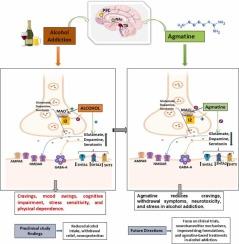胍丁氨酸治疗酒精使用障碍的潜力:临床前观察和未来方向。
IF 2.3
3区 心理学
Q2 BEHAVIORAL SCIENCES
引用次数: 0
摘要
酒精使用障碍(AUD)是一项主要的全球健康挑战,其特征是酒精消费的复发、戒断症状以及重大的社会、经济和健康相关负担。尽管有传统的治疗方法,如认知行为疗法和药物,如双硫仑和纳曲酮,但由于这种疾病的多因素性质,包括心理健康问题和神经适应性变化,大多数患者并没有得到充分的缓解。最近的研究表明,长期饮酒会导致内源性agmatine(一种由l -精氨酸合成的神经调节剂)的产生和信号传导中断。胍丁氨酸调节神经递质系统,特别是在NMDA和咪唑啉位点,这与神经炎症和神经可塑性有关。此外,在临床前模型中,胍丁氨酸代谢的改变与酒精寻求行为的变化有关,这突出了它作为一种新的治疗候选者的潜力。此外,胍丁氨酸可能减轻酒精引起的神经毒性的行为和生化效应,表明其在改善耐受性管理和戒断症状方面的潜在作用。将agmatine整合到多模式治疗策略中,可以对AUD患者进行全面的个性化干预,解决与该疾病相关的神经化学失衡和社会心理复杂性。因此,本综述探讨了agmatine在解决AUD背后的心理因素方面的潜力,为推进未来的治疗方法提供了一种新颖而乐观的治疗选择。然而,全面的临床试验对于确认这些益处并建立最佳给药方案和人类环境下的长期安全性至关重要。本文章由计算机程序翻译,如有差异,请以英文原文为准。

Therapeutic potential of agmatine in alcohol use disorder: Preclinical insights and future directions
Alcohol Use Disorder (AUD) is a major global health challenge characterized by the recurrence of alcohol consumption, withdrawal symptoms, and significant social, economic, and health-related burdens. Despite conventional treatments such as cognitive behavioral therapy and medications like disulfiram and naltrexone, the majority of patients do not achieve adequate relief due to the multifactorial nature of this disorder, including mental health issues and neuroadaptive changes. Recent studies demonstrated that chronic alcohol consumption results in the disruption of both the production and signaling of endogenous agmatine, a neuromodulator synthesized from L-arginine. Agmatine modulates the neurotransmitter systems, particularly at NMDA and imidazoline sites, which are associated with neuroinflammation and neuroplasticity. Moreover, in preclinical models, altered agmatine metabolism is related to changes in alcohol seeking behavior, highlighting its potential as a novel therapeutic candidate. Furthermore, agmatine may mitigate the behavioral and biochemical effects of alcohol-induced neurotoxicity, indicating its potential role in improving tolerance management and withdrawal symptoms. Integration of agmatine into a multimodal treatment strategy could lead to comprehensive personalized interventions in patients with AUD, addressing both neurochemical imbalances and the psychosocial complexity associated with this disorder. Thus, this review explores the potential of agmatine in addressing psychological factors underlying AUD, offering a novel and optimistic treatment option for advancing future therapeutic approaches. However, comprehensive clinical trials are essential to confirm these benefits and to establish optimal dosing regimens and a long-term safety profile in human settings.
求助全文
通过发布文献求助,成功后即可免费获取论文全文。
去求助
来源期刊

Behavioural Brain Research
医学-行为科学
CiteScore
5.60
自引率
0.00%
发文量
383
审稿时长
61 days
期刊介绍:
Behavioural Brain Research is an international, interdisciplinary journal dedicated to the publication of articles in the field of behavioural neuroscience, broadly defined. Contributions from the entire range of disciplines that comprise the neurosciences, behavioural sciences or cognitive sciences are appropriate, as long as the goal is to delineate the neural mechanisms underlying behaviour. Thus, studies may range from neurophysiological, neuroanatomical, neurochemical or neuropharmacological analysis of brain-behaviour relations, including the use of molecular genetic or behavioural genetic approaches, to studies that involve the use of brain imaging techniques, to neuroethological studies. Reports of original research, of major methodological advances, or of novel conceptual approaches are all encouraged. The journal will also consider critical reviews on selected topics.
 求助内容:
求助内容: 应助结果提醒方式:
应助结果提醒方式:


